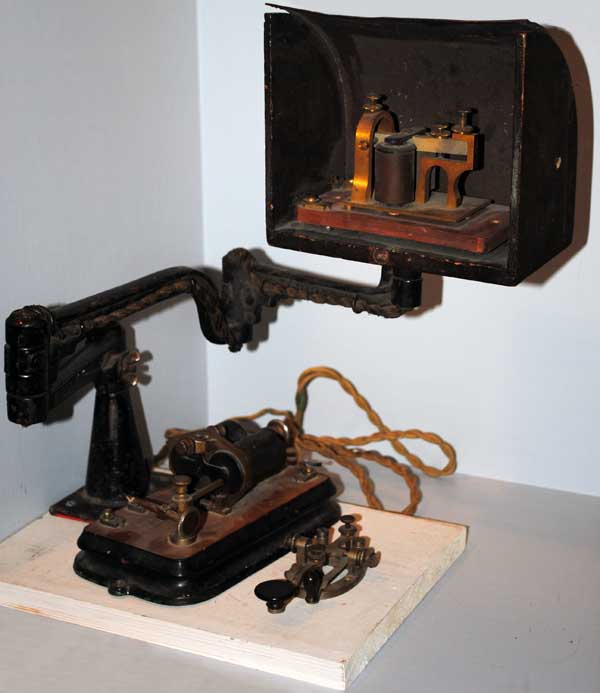
The Horse Horse & Buggy Era (1880-1900)The Tichborne Station Telegraph |
|||
|
|||
Telegraph used at the Tichborne and Parham
|
By the mid-nineteenth century, the telegraph served as a community's link to the outside world, offering a way to send messages between remote rural communities and major urban centres. The first telegraph in North America was conceived by Samuel Morse in 1837, but Canada's first telegraph company, the Toronto, Hamilton and Niagara Electro-Magnetic Telegraph Co., was not established until 1846. DISCOVER MORE![]()
Telegraph keys were used by telegraphers to encode, transmit and decode messages sent along the wire. A special telegraphic alphabet, Morse code, was used to send messages by way of a series of dot, short-dash, and long-dash sounds. The audible clicking noise was transformed by a sounder, and then focused into a resonator hood, which allowed the signal to be heard by the operator. Volume had to be loud to ensure the telegrapher could hear each click in the noisy environment of a busy railway station.
Telegraph lines were often built along railroad rights of way, which made the lines easily accessible to repair crews. In return, railways relied on telegraphs to report train loads, manage schedules, and prevent collisions. Small communities were often served by a telegraph office or railway station, but if they were fortunate, they were served by both.
The railway arrived in Napanee in October 1856, when the Grand Trunk Railway route from Montreal to Toronto opened. By the time Stephen Benson photographed his Napanee views in the 1860's, the telegraph had arrived. At the Grand Trunk Station, Robert McCrossie was employed as a telegraph operator. The 1874 Bird's Eye View of Napanee shows telegraph lines stretching along the Grand Trunk tracks.
In 1879, construction began on another railway linking Napanee to Tamworth. The Napanee, Tamworth and Quebec railway opened in 1884, stopping in communities along the Napanee River Valley. Extensions were laid to Tweed in 1888, Harrowsmith in 1889 and Sydenham in 1893. The same year, the line, renamed the Kingston, Napanee and Western Railway, merged into the Bay of Quinte Railway. In 1914, it was purchased by the Canadian Northern Railway.
NTQ trains had running rights over the rails of the Kingston and Pembroke line into Kingston from Harrowsmith. The "Kick and Push", incorporated in 1871, had been completed to Renfrew by 1884, the year the NTQ line opened. In 1912, the line was leased to the Canadian Pacific Railway.
The telegraph illustrated was used at the Tichborne and Parham railway stations on the Kingston-Pembroke line. It has an adjustable swinging arm which allowed the telegrapher to move the resonator close to his or her ear the best volume possible. This telegraph was manufactured by the O.C. White Company, of Worcester, Massachusetts, which was founded in 1883, by Dr. Otis C. White.
© Lennox & Addington County Museum & Archives
97 Thomas Street East, Napanee, Ontario, Canada K7R 4B9
Funding provided by the Government of Ontario and the County of Lennox & Addington




